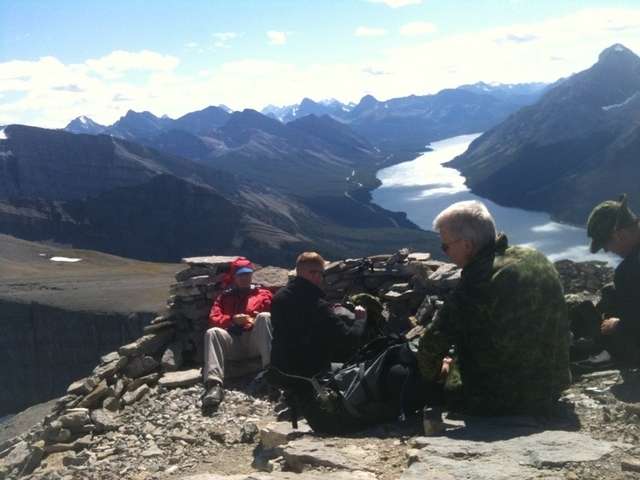
Sunday, December 25, 2011
Seen On The Morning Run

Saturday, December 24, 2011
Luke and Linus: A Sermon for Christmas Eve
Christmas Eve, 2011
Lectionary Year B, Isaiah 9:2-7, Psalm 96, Titus 2:11-14, Luke 2:1-14 [15-20]
The hip and cool coffee retailer Starbucks (or “Tenbucks” for those of you who prefer the cheaper and more wholesome ambience of Tim Hortons, is very shrewd about its holiday marketing. As folks wait to place orders for their eggnog lattes, they can browse a small selection of music. The music, like the coffee, is usually very hip and cool, but at Christmas, praise be, Stabucks includes The Charlie Brown Christmas. Perhaps this selection is marketing aimed at nostalgic baby boomers like myself, who grew up with this cherished TV special. Perhaps its also aimed at hip, sophisticated types who will appreciate the jazz score by Vince Guaraldi. But it’s there, in Starbucks of all places, and it’s not called A Charlie Brown Holiday Special. It’s called A Charlie Brown Christmas. That in itself is so cool as to be practically miraculous, but not as miraculous as the story of the making of the little TV show that became an icon.
Back in 1965, in the slick, corporate America depicted in Mad Men, Charles Schulz and his business partner Bill Melendez had received a small amount of money to create a half hour TV Christmas special featuring characters from Schulz’s popular cartoon strip, Peanuts. The made the show on a shoestring budget and then went shopping for a netork sponsor and pitched the show to CBS. At first the network shied away from it. They didn’t like the child actor’s voices, the animation looked too primitive to them, and they didn’t think the jazz soundtrack would appeal to mainstream America. But most of all, the network suits were afraid of the Christian content. Not only did the Peanut’s gang sing “Hark the Herald Angels Sing” but Linus reads the whole nativity story from Luke, just as we heard it in tonight’s gospel. It took a last minute appeal by Melendez to personally sell the network president, who finally relented, even though he grumbled that airing the Peanuts special would mean preempting an episode of The Munsters.
The result was TV history. When it aired on CBS on December 9, 1965, the Peanuts Christmas special was seen by half of the households in the US. This show has become an icon, part of the memories and Christmas tradition of several generations. Today Canadian Tire and other retailers offer a Charlie Brown Christmas tree, and a DVD collectors edition is available at Starbucks. Something in that half hour show, so primitive by today’s production standards, has touched a deep chord of hunger and need in millions of people over 45 years, and the reason for that is, I believe, quite clear. I believe that the real magic in that show comes towards the end, when Linus finishes reading the Lukan nativity in the ancient King James language and says “That’s what Christmias is all about, Charlie Brown”. When we hear Linus says that, we know in our hearts that he’s right, he’s nailed it. Years later, when Charles Schulz described how he had to fight to keep the reading from Luke in the show, and he told how he said to his partners, "If we don't tell the true meaning of Christmas, who will?"
As Christians we have a pretty clear sense of what the true meaning of Christmas. At its heart is the idea of Emmanuel, the promise that God is with us. The birth of Jesus reminds us of God’s love and solidarity with us, of his refusal to be a distant, unknown and feared God. We may not understand or grasp all the majesty and mystery of God, but in Jesus we have a way of approaching and understanding God and, because God’s son chose to share our human condition, we know that God understands us as well. We also know that the birth of Jesus is connected to God’s desire to rescue us by taking on all aspects of the human condition, including the hatred, fear, violence, and greed that we call sin. That is the connection between Christmas and Easter that is expressed in the Magi’s gifts of frankinscence and myrrh, things associated with funerals and burials, because Christ is born to die for our sakes. Christmas is about our rescue from loneliness, darkness and death.
All of these themes are expressed in the Charlie Brown Christmas special. Think of Charlie Brown, plunged into darkness and despair by the cruelty and scorn of the people around him and by the soullessness and commercialism of a world that we only see at night. Then think of how Linus brings his friend out of this darkness through reminding him of Luke’s gospel story, helps bring Charlie Brown’s dying little scrap of a tree back to life, and reunites Charlie Brown with the other children, who are no longer scornful and cruel and have become gentle and loving. In his simple and brilliant way, Schultz uses the story of Charlie Brown to act out the themes of rescue, redemption and resurrection that are part and parcel of the gospel of the birth.
Tonight I’ve talked about stories that breath life and hope and magic into the world. The world of 1965 was different from the world of 2011 in many ways, and certainly far different from the world of Augustus and Quirinius that Luke takes us too. But in essence it was and is the same world. It was and is a world of darkness, a world made tired by fear and greed. But it was and is the world that God made and loved and loves today, the world that God’s son was born into and continues to be born into each and every Christmas It was and is a world that the light of Christ stubbornly comes to, whether in the flickering torches of the manger and the star from the east, or the flickering light of a 1965 TV show, or in the LED lights and displays of today, for across the years and to all of us “is born this day in the city of David a Saviour, who is the Messiah, the Lord”. Thanks be to God.
A Fantasy For Christmas Eve
“For the grace of God has appeared, bringing salvation to all”. Titus 2:11
It’s dark when the sound wakes you. Not some polite “is anyone at home” tapping at the front door, but a loud urgent banging, as if someone’s trying to tell you that the house is on fire. The person at the door may be someone you’ve known all your life, or it may be a mere acquaintance, but the expression and a few urgent words are enough. You know that if you don’t go with this person, you will regret it for the rest of your life.
There may be a sleepy child and a protesting spouse that you have to wake and bundle up, or it may be that you’ve been alone in this house for far too many years. You struggle into coat and boots and follow the messenger into the cold night air, to where a vehicle sits running. Perhaps you slide onto the leather seats of a sleek import, or sit on the cracked vinyl of a muddy farm truck, smelling comfortably of wet dog and gun oil. You head off into the night.
A few folks have left their coloured lights on, but without the snow and in the damp night they seem pale and dim. For years you and your neighbors have hung lights and decorated for a time you’ve called the holidays, with only a vague sense of what it all means, and a nameless hope that somehow the lights and the gifts will keep the darkness at bay. Tonight this is hope is faint, and the town huddles into itself, surrounded by dark and wet fields, as if not even daring to dream.
You head into the dark tunnel of the night, and then your driver points to a something. At first it’s a glow glimpsed through the tree tops, but once you’re in open country you see it clearly through gaps in the scudding rain clouds. A comet or meteor, perhaps, hanging low in the sky, a clean, silvery glow, like running water sparkling on a sunny day. It’s like your dearest memory of seeing the northern lights when you were a kid, only purer and more magical, if that is possible. As you drive you feel a nameless sense of expectation.
You realize that you’re not alone on the road, even at this late hour. Other vehicles are heading in the same direction. You start to wonder what concession you’re on, because the landscape looks unfamiliar in the silvery night. Finally you pull off a gravel road into a deeply rutted farm laneway, and stop where the others are parking.
The ground is wet and the mud pulls at your boot as you make your way up the lane. You pass an old delivery truck bearing the name of a long defunct business, and a Chevy of a vintage normally seen at heritage shows. Others are walking with you now, and some are neighbours and you nod to them, but others are strangers, and some are adults you remember from when you were a kid, all walking with you up this laneway.
A small crowd has assembled in front of a barn that’s seen better days. You see people you know – Anne from curling and Joe from Lions and the couple who run the restaurant, and Mr. Olson, your schoolbus driver from long years ago. They’re mixed in with strangers in muttonchop whiskers and tight bun hairstyles you’ve seen in old pictures. An immigrant family in rough workclothes stands beside a group of First Nations people in deerskin and fur wraps. To one side is a small knot of olive-skinned, bearded men in thick homespun, carrying serviceable crooked sticks and one holding a young lamb, and beside them a homeless man in an old parka and some folks from the Crest Centre. All patiently wait their turn until, in ones and twos, they can enter the barn and look inside. Breaths mingle in the night air, but you notice that you’re not cold.
You watch those coming out of the barn, and each is different. Some are grinning and some look quiet and thoughtful, but all seem taller as they leave, and their faces are bright with some new inner glow. Then it’s your turn, and you push back a rough sheet of plastic and enter. Inside it’s fragrant with straw and warm animals. A single light bulb hanging from a wire reveals two strangers, a very young woman, and behind her an older man, his body hardened with work but his face gentle. Their newborn child is wrapped in clean horse blankets and cushioned amidst a pile of woolsacks and feed bags. Two barncats watch with glittering eyes, and a horse snuffles in the shadows.
You don’t wonder at why these people and this child are here, and not in some clean hospital. You only draw closer, holding your breath, until the mother smiles her permission at you and you find yourself kneeling in the clean straw. The child opens his eyes and looks at you, like no other person has ever looked at you before. You feel a great surge of release as the locks on the secret and shameful places of your soul open, and the iron doors of regret and long-nurtured anger open to the bright light of this child’s presence. You feel cleansed and scoured, your soul freed of its grime and cobwebs. You realize that you’re not alone, not left to suffer and doubt and fear. Somehow, you know that this child has come to serve, has come to keep company, has come to save.
As you stand and prepare to leave, the child holds your gaze a moment longer and you realize that this gift is not for you alone. It is for all those here with you, and for those in countless other places. You realize that this child is also present in nursing homes and small towns, in city shelters, in army camps, in hospitals and prisons and every place in between. He is here now, in this moment, and in all the times before and in all the times to come.
And so you leave this place, and turn back into the night. Outside in the farmyard and in the surrounding fields, the mud and the wet are gone, covered by snow that is whiter and cleaner than any dream of childhood winters. The dismal rain clouds are gone, and the sky is ablaze with stars, as if escorting that one silver light that still draws newcomers up the laneway. You and your companion make your way back to the car, walking with others. People are thoughtful and quiet, but you exchange looks with Ann and John and Mr. Olsen and the folks from the old pictures. You know now that the child loves all these people, and somehow all carry the marks of that love in their gentleness to one another.
Your companion head the car back down the laneway. Later you could never recall how long it took to get back to town, whether it was minutes or hours, but it was long enough for the stars to grow pale and for a golden sun to start climbing into the clear blue sky. Your last memory is singing the old carols together as you neared home, something about a little town where the hopes and fears of all the years have come together in this one night.
©Michael Peterson+ 2006
Thursday, December 1, 2011
Back To The Summer: Adventure Training In The Rockies
In August I was lucky enough to get a spot on an Adventure Training trip to Alberta's Rocky Mountains, in the Kananaskis region. Adventure Training is army speak for going on a rather strenuous holiday at taxpayer's expense, so to you, the Canadian taxpayer, my thanks.
Our leader was Major Charlie McKnight, a qualified mountain warfare instructor who knows the Rockies as well as anyone, so we were in excellent hands. Three non-commissioned members, myself, and another officer signed on to do three peaks in three days, all of us thinking that mountains were kind of tall and steep, but not doubting we could do this thing. After all, the climbing we would be doing is called "scrambling", which is not technical climbing with ropes, pitons, and the like. Even so, it was more than a walk in the park. As the Major said several times in a jovial but serious way, "Pay attention to me, because mountains can kill you." We paid attention. It turned out to be one of the most rewarding and challenging things I've ever done.
Our first climb was a peak known as Windy Tower, an imposing looking slab of rock when seen from the parking lot. The first few kilometres were along an almost unforgiving forest trail that had me stopping and wheezing every few hundred metres. It only took us an hour on this trail to be thankful for the trekking poles we were instructed to bring. They proved invaluable in propelling us upwards.

Our lungs and body soon acclimated and within a few hours we had cleared the treeline. As we climbed, Spray Lake, a large and long lake beneath us, steadily grew smaller. As we neared the summit, we learned why the peak was named Windy Tower. Despite the warmth of the summer day we had felt earlier, on the summit we quickly broke out jackets and fleece vests, and I had to jam my hat firmly on my head to keep it from blowing away.
Dave Williams admires the view from Windy Tower. I couldn't bring myself to accept his offer to sit beside him, it was too far down.

Me looking self-satisfied at the top of Windy Tower:
At the restaurant that night, the only part of me that didn't feel destroyed was my appetite. It was all I could do to shuffle to the barstool-type seat at our group's table, and the climb up exhausting, but the food (no beer or alcohol allowed) was heavenly. Then back to our spartan accomodations at Trail's End Camp near Cochrane, AB, at the facility the British army uses for adventure training and kindly leant to us.
Our goal the next day was The Fortress, near Canmore, AB. At 9,843 ft or 3000m, it ranks as the 262nd highest mountain in Canada. 
Our approach route had to be improvised at the last minute by Major McKnight, since the path he had wanted to take was closed due to bear activity. He found us a route that followed a logging road for several kilometres, then took us along a forest path that skirted several avalanche routes. The Major pointed out several places where recent avalanches had damaged and carried away trees. Seeing a massive tree trunk smashed to kindling made me respect what an avalanche can do.
Between the treeling and the base of the summit, we had to navigate two short cliffs, called headwalls. After struggling up them on paths that sometimes seemed vertical, we were greeted by wondrous sights, two small hanging valleys, each with a waterfall-fed lake. This one, as I recall, was stocked with fish for any hardy angler that might lug a pole up to it.
Me looking tired but still self-satisfied on top of The Fortress. The little stone statues, inukshuks, were everywhere on the mountains.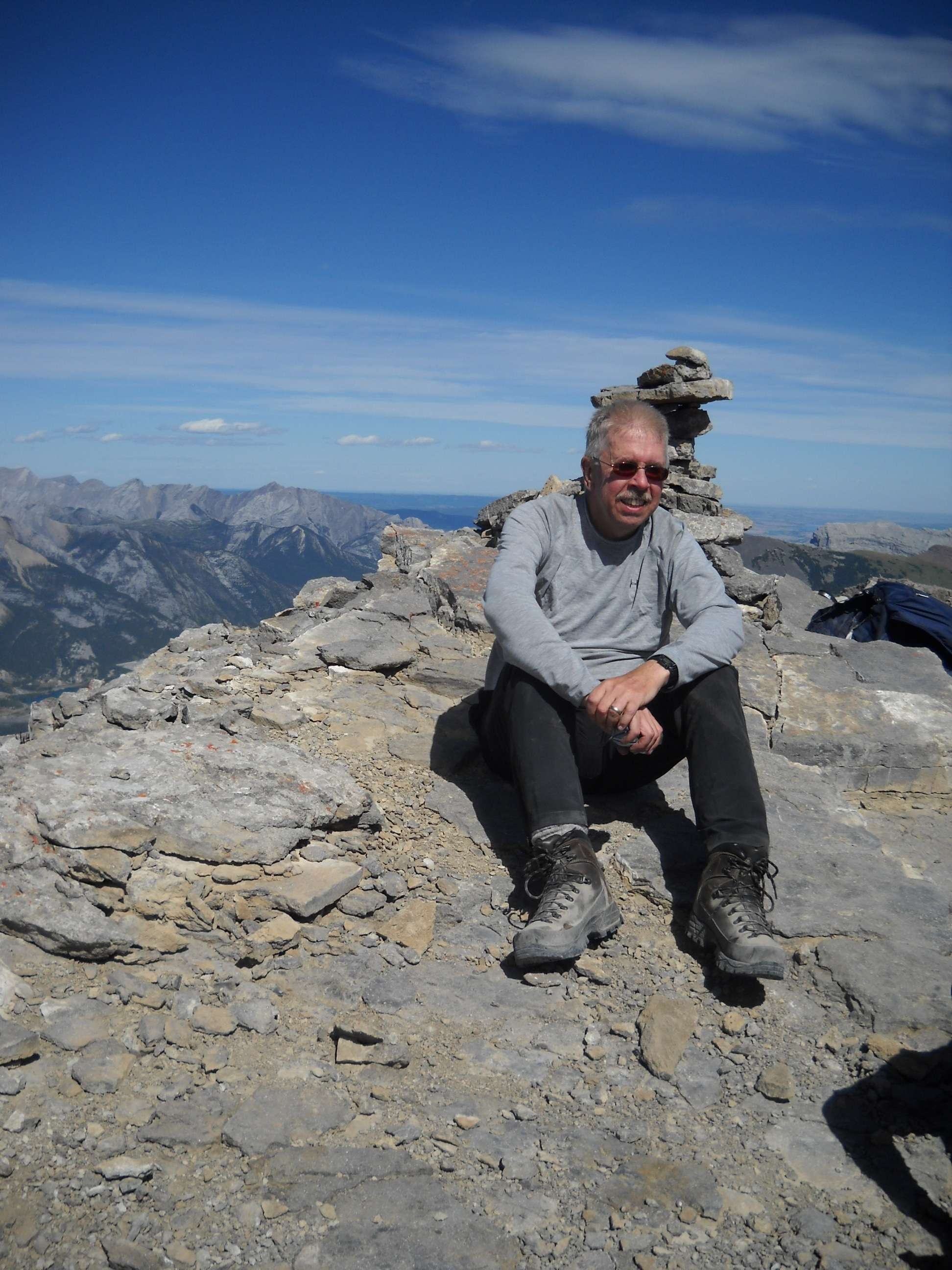
Our final day's climb was Mount Yamnuska. As seen in this picture, our route would take us up to the base of the mountain and then its right flank to climb it from behind. Coming back down, we would circle the mountain from behind, come around its left flank, and the descend the scree slopes in the centre of this image, following the white paths you can see in the centre.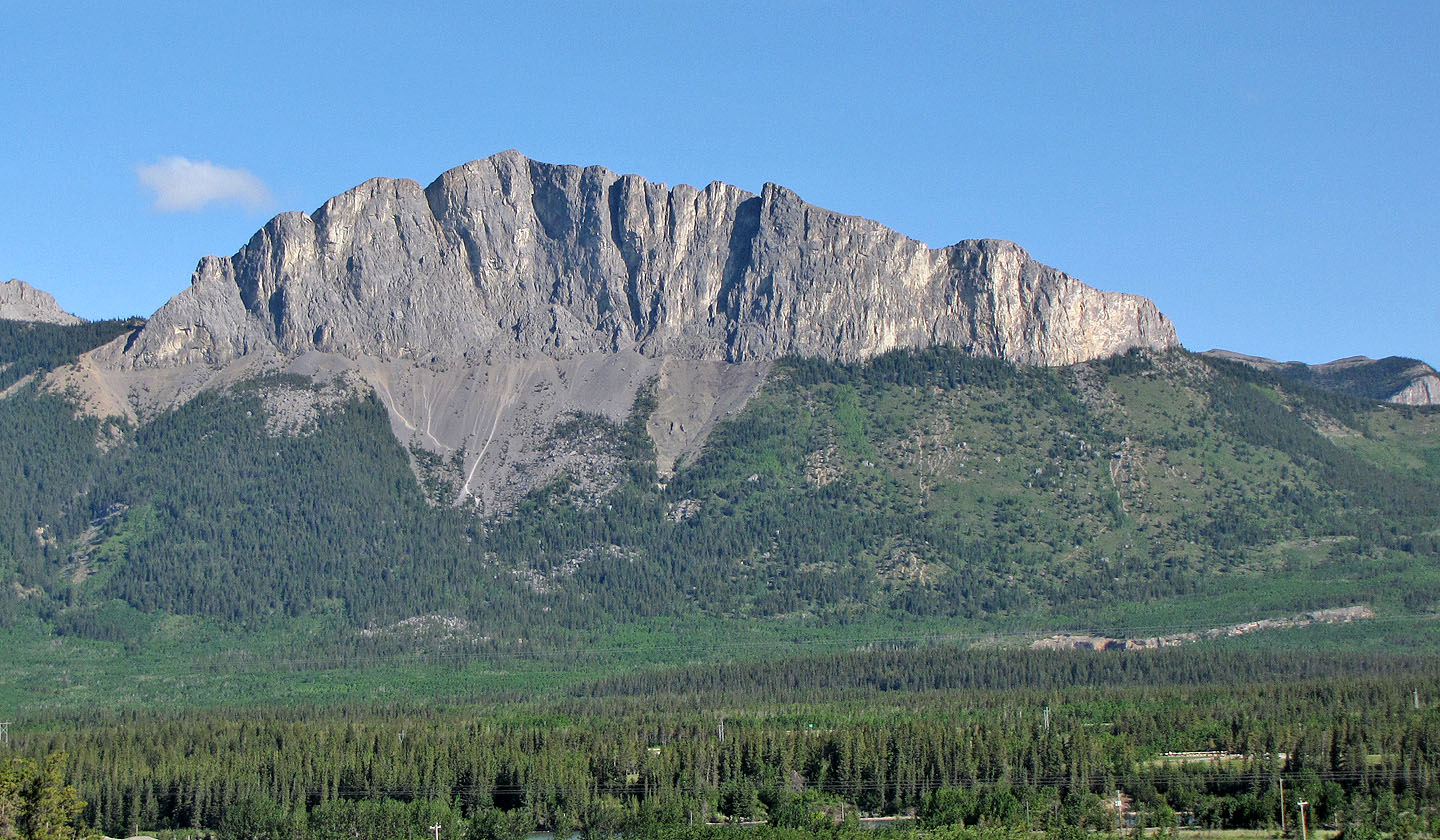
Yamnuska had some interesting features, including an ascent of several hundred feet through a moderately challenging chute of rock. In this picture, Maj. McKnight is working his way up after carefully watching us all ascend.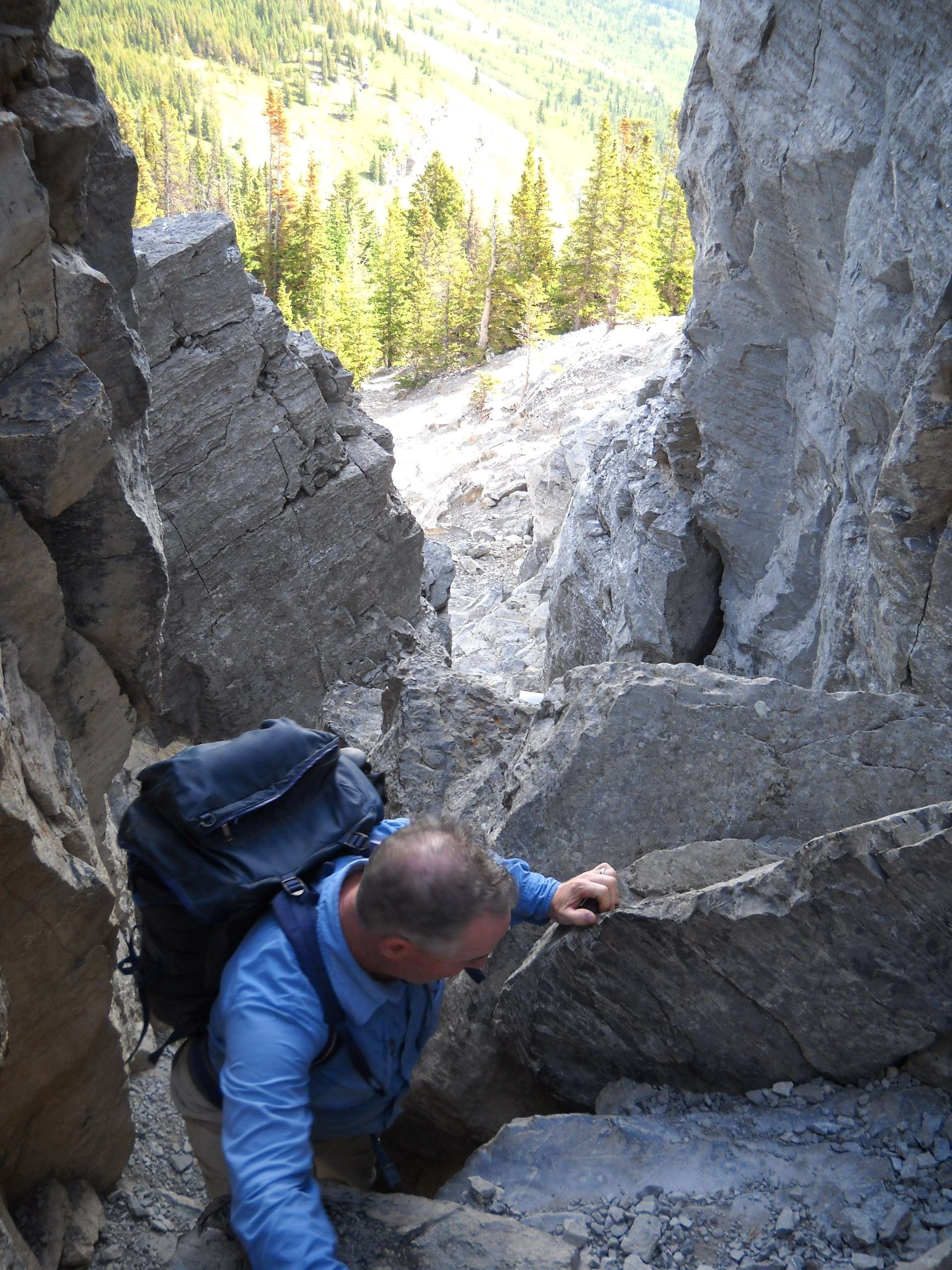
Another challenging section was a ledge, about five feet wide in sections, several hundred feet in length, that had to be traversed with the aid of a stout cable at waist height. The cable and one's balance were all that prevented a nasty and almost certainly fatal fall, so it took a bit of concentration. This is Dave Williams crossing the ledge.
After a trip of about four hours up, our team at the top of Yamnaska. Back row: Master Bombardier , Major Charlie McKnight, Corporal Nick Gervais, Corporal Klayton Heal. Front row: Captain Dave Williams and myself.
Our descent was quite a bit faster because of the scree slopes I mentioned earlier. A mountain looks subtantial from a distance, but in reality it is fighting a losing battle against gravity, weather and erosian, and much of a mountain is in small pieces. Below Yamnaska were long slopes of small rock which cushioned and absorbed your impact as you ran and leaped down them. Maj. McKnight called it "running on the moon" and he showed us the way, making long, graceful leaping steps that ate up hundreds of metres in just a few seconds. This is me, looking considerably less graceful.
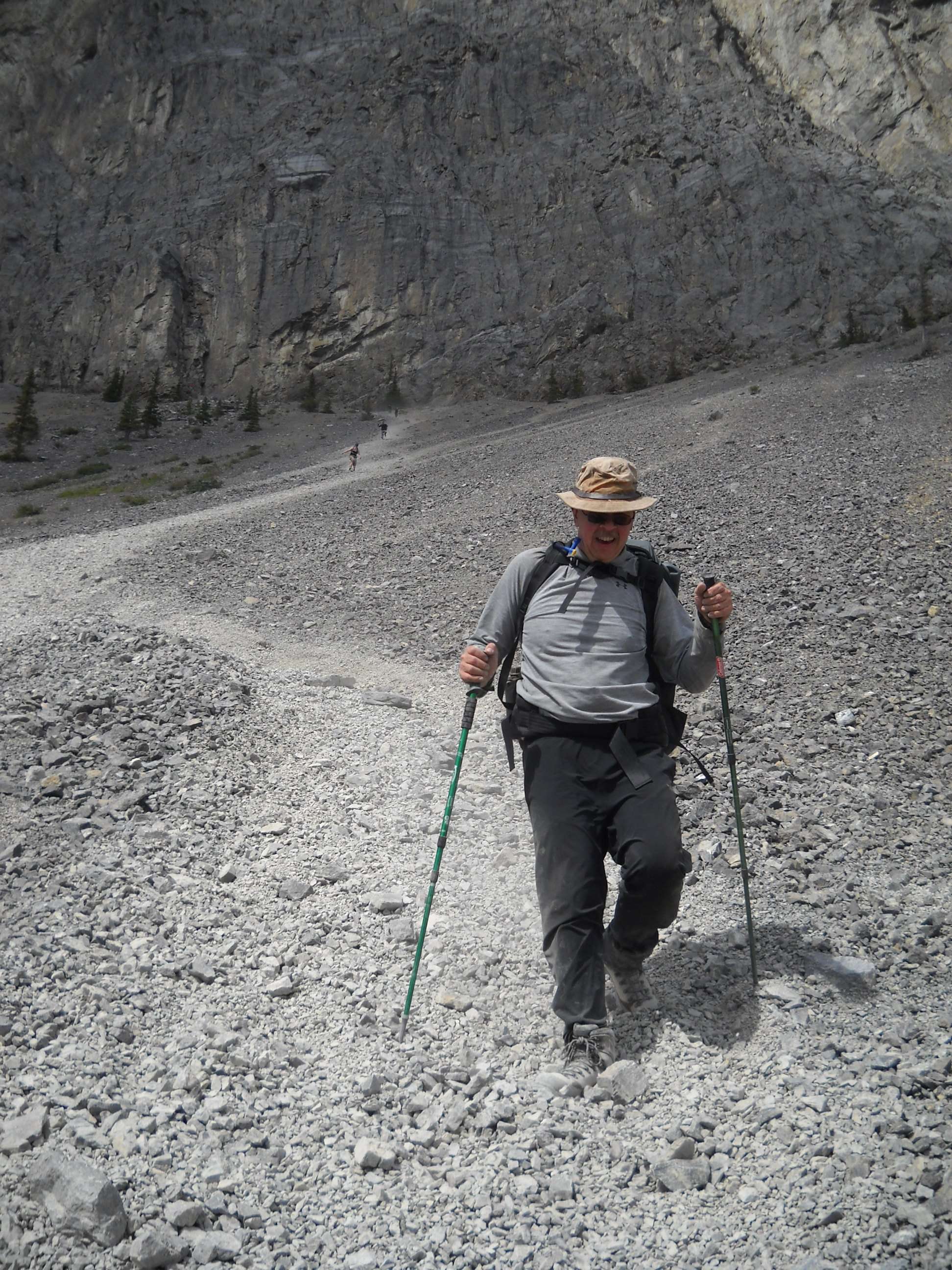
We had started the climb at about 08:00, and by mid afternoon we were all safely down. Three climbs in three days left us in various degrees of stiffness and agony, and I was walking like a man in his nineties. But for those of us who were new to the mountains, we had seen and done things that were incredible. It's hard to relate the sense of engaging with these peaks that look impossibly grim from the highway, learning their secret routes, and gradually realizing that you have ascended to what seems like the highest point in the world. From these heights, you have a sense of how incredibly fragile the human body is against sheer height, empty space, and rock, and yet how beautiful the world is. For Major McKnight, a man as comfortable in this world as in his own backward, we all felt enormously grateful for his leadership and oversight, and for me at least, some of his enthusiasm rubbed off. I will be back to the mountains this coming summer, I am sure.
Mad Padre

Opinions expressed within are in no way the responsibility of anyone's employers or facilitating agencies and should by rights be taken as nothing more than one person's notional musings, attempted witticisms, and prayerful posturings.
Followers
Blog Archive
Labels
- Advent (7)
- Adventures in Alberta (11)
- Adventures in Atlantic Canada (17)
- Adventures in Ontario (2)
- All (1)
- All Saints Collingwood (144)
- All Saints King City (128)
- American Civil War (2)
- Angl (1)
- Anglican (1)
- Anglican Church (351)
- Anglican Military Ordinariate (6)
- archaeology (1)
- Beer (2)
- Blogs and Blogging (13)
- Book Reviews (58)
- C.S. Lewis (1)
- C.S. Lewis and Narnia (2)
- Canada At War (18)
- Canadian Armed Forces (25)
- Canadian Forces Chaplain School (2)
- Canadian Military History (1)
- Chaplain Stories (23)
- Chaplaincy Issues (7)
- Children's Ministry (10)
- Christianity and Islam (4)
- Christianity and Society (14)
- Christmas (3)
- Church and Society (8)
- Church History (11)
- Climate (1)
- Climate and Environment (1)
- Conversations (1)
- Cool Stuff (11)
- CS Lewis (1)
- Cultural Studies (1)
- Daily Devotional (37)
- Daily Office (2)
- Death and Dying (5)
- Depression and Suicide in the Military (10)
- Diocese of Toronto (2)
- Drones (3)
- Easter (2)
- ebooks (7)
- Ecumenism (1)
- Epiphany (6)
- Ethics and Society (31)
- Eucharist (1)
- Evangelism (1)
- Family News (5)
- Films (4)
- Firearms (1)
- First World War (2)
- Flowers (1)
- Food Insecurity (1)
- Friday Theology (19)
- Funerals (6)
- Funny Stuff (36)
- Gaming and Ethics (7)
- Good Friday (2)
- Great War (3)
- Grief and Loss (1)
- Hebrew Scriptures (3)
- Holy Week (7)
- Homiletics and Preaching (6)
- Interfaith Dialogue (3)
- J.R.R. Tolkien (1)
- Jordan Peterson (2)
- Judaism (2)
- Language Play of the Week (9)
- Lent (46)
- Lent Madness (1)
- Lent Madness 2023 (20)
- Lent Madness 2024 (20)
- Lent Madness 2025 (1)
- Literacy and Literature (12)
- Literature and War (2)
- Liturgy (3)
- Living History (1)
- Marriage and Relationships (6)
- Marriage and Society (3)
- Me and My iphone (12)
- Mental Health (9)
- Military and Literature (2)
- Military and Society (59)
- Military and Spirituality (40)
- Military and Suicide (13)
- Military Chaplaincy (109)
- Military Culture (7)
- Military Ethics (68)
- Military Families (10)
- Military Goats (11)
- Military History (67)
- Military History American Civil War (5)
- Military Humour (32)
- Military News (220)
- Military Picture of the Week (36)
- Military Rantings (10)
- Military Reading (3)
- Military Service (42)
- Minature Wargames - My Figures (18)
- Miniature Wargames - Battle Reports (11)
- Miniature Wargames - Miscellaneous (2)
- Music (2)
- Oh Canada (10)
- Over There (122)
- Pandemic (1)
- Physical Fitness (1)
- Pluralism (1)
- Poetry (1)
- Prayer (3)
- Psalms (1)
- PTSD Issues (45)
- Random Stuff (1)
- Reconciliation (2)
- Regional Ministry (1)
- Religion and Conflict (5)
- Religion and Society (76)
- Religion In The News (12)
- Remembrance Day (2)
- Royal Canadian Regiment (4)
- Running (37)
- Sacraments (1)
- Saints (18)
- Saints Days (3)
- Seen on the Run (16)
- Self Care (1)
- ser (1)
- Sermon (3)
- Sermons (382)
- sermons Anglican church all saints collingwood (1)
- Social Justice (1)
- Society of St. John the Evangelist (SSJE) (1)
- Spirituality (23)
- Synod (1)
- Technology and Humanity (1)
- Terrorism (1)
- The Bible and Society (4)
- The Great War (1)
- The Secular (1)
- Theology (35)
- Tolkien (1)
- Tom Holland (1)
- Travel Stories (3)
- Trinity Barrie (1)
- Truth and Reconciliation Canada (2)
- Video Gamex (1)
- Volkswagen Westfalia (8)
- Wanderings (8)
- War and Literature (3)
- Worship (4)

